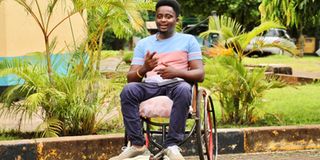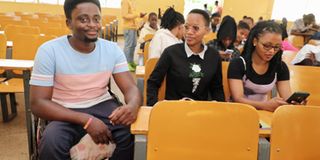Prime
Beyond buildings: The human impact of inclusive education

What you need to know:
- A quiet revolution is reshaping higher education-one ramp, one accessible classroom, and one trained lecture at time. Universities are embracing diversity not as a duty, but as a core values. The transformation goes beyond infrastructure; it's a cultural shift affirming every student's right to learn, lead and thrive in inclusive spaces.
At the base of the picturesque Mount Kilimanjaro lies Moshi Cooperative University (MoCU), a campus once defined by buildings from the 1960s—old, narrow-doored structures with steep staircases, inaccessible restrooms, and gravel paths. Today, it tells a different story: a story of inclusion, a story of hope.
Among the many who now carry that hope with a smile is Emmanuel Kelvin, a 21-year-old first-year student pursuing a degree in Information Technology. A road accident in his early teens left him without the use of his legs, and his dream of higher education once seemed distant, if not impossible.
“I thought my disability would be a burden here,” Kelvin shared, his eyes glinting with newfound confidence. “I believed I’d be misunderstood, and I expected the infrastructure would fail me. But when I arrived, I was surprised. There are ramps, accessible classrooms, and wheelchairs. If my class is far, there are bajajis (tricycles) ready to assist us.”
Kelvin is one of many students benefiting from Tanzania’s Higher Education for Economic Transformation (HEET) project, a government-led initiative funded by the World Bank. With $425 million injected into the higher education system, inclusive education has become more than just a policy—it is now a practice.
Tanzania’s commitment to inclusive education began decades ago. It was enshrined in the 1978 Education Act and later reinforced by international agreements such as the Salamanca Statement (1994) and the Dakar Framework (2000).
The country’s National Strategy on Inclusive Education echoes Sustainable Development Goal 4, which calls for “inclusive and equitable quality education and promotion of lifelong learning opportunities for all.”
But commitment alone was not enough.

Emmanuel Kelvin (left), a first year student at Moshi Co-operative University (MoCU) in class. PHOTO | COURTESY
As MoCU’s expert in inclusive education and gender under HEET, Dr Asteria Gaiza, explains:
“Old infrastructure from colonial times was a real challenge. Students using wheelchairs couldn’t attend classes upstairs, restrooms lacked proper fittings, and teaching staff had limited awareness on accommodating students with disabilities.”
MoCU’s transformation under HEET
Established in the 1960s, MoCU is one of the universities that received significant support from the HEET project, with Sh18.3 billion allocated to improve infrastructure, curriculum, and learning environments. According to the Vice Chancellor, Prof Alfred Sife: “HEET has revolutionised higher education. With these funds, we’re constructing new ICT and academic buildings that are fully accessible. We’ve also rehabilitated older structures to include walkways and ramps, making the entire campus friendly for students with disabilities.”
Before HEET, students with disabilities at MoCU were often addressed under broader gender policy frameworks. Today, that has changed.
“We’ve developed an independent special needs policy and guidelines that clearly define responsibilities and actions. This has been a game-changer,” Prof Sife added.
As part of its implementation, the HEET project has gone beyond physical infrastructure. It supports training for faculty and administrative staff, equipping them to identify and support students with disabilities.
“Previously, many of our lecturers didn’t know how to recognise or support students with special needs,” Dr Gaiza noted. “Now, we run regular workshops. Faculty members are more responsive and adaptive in their teaching.”
“Previously, many of our lecturers didn’t know how to recognise or support students with special needs,” Dr. Gaiza noted. “Now, we run regular workshops. Faculty members are more responsive and adaptive in their teaching.”
In addition to capacity-building, MoCU has established assistive services and safe spaces. Restrooms, lecture halls, and libraries now accommodate wheelchair users, visually impaired students, and others needing tailored support.
While MoCU is making impressive strides, the University of Dar es Salaam (UDSM) remains the flagship for inclusive education in Tanzania.
At UDSM, the HEET project has facilitated the construction of a special facility dedicated to gender and disability issues. The centre provides counselling, academic resources, and assessment services such as hearing impairment diagnosis.
UDSM has set the pace in mainstreaming inclusive education through its Department of Special Needs Education, inspiring other institutions like MoCU to follow suit.
“We’ve learned a lot from UDSM’s model,” Dr Gaiza admitted. “Their success influenced how we designed our buildings and shaped our inclusive policy and we have always invited trainers to come and help our staff.”
Parents share their hope
For many families, these developments bring immense relief. The mother of a visually impaired student enrolled at MoCU, Janeth Shija, expressed her gratitude:
“As a parent, I used to fear sending my child to university. I didn’t know if he would be safe or supported. Now, when I visited the campus, I cried. The ramps, the kindness of staff, the braille books—it’s unbelievable.”
She believes that the HEET project has changed not just buildings, but attitudes.
Speaking to The Citizen, an official from the Ministry of Education, Science and Technology emphasised the government’s prioritisation of inclusive education through HEET:
“We are not just building universities; we are building equal opportunities. HEET is not a luxury—it’s a necessity to meet our SDG goals and national development plans.”
The Ministry has organised multiple training sessions for university staff and continues to encourage the establishment of Disability Support Units in all public universities.
The impact is already visible in the numbers. According to MoCU, all current academic buildings are now disability-friendly. The number of students with special needs has increased by 35 percent over the last two years.
According to Prof Sife, over 50 staff members have received training on inclusive education practices and a new Digital Accessibility Lab is underway to support visually and hearing-impaired students.
Voices of change
Kelvin now moves freely around campus, even participating in student leadership activities. He’s also helping new students with disabilities acclimate to university life.
“I want to be someone’s reason to believe in possibility,” he smiled. “I came here scared, but today, I am proud.”
The transformation sweeping through Tanzania’s universities is more than concrete and ramps. It’s about dignity. It’s about voice. It’s about breaking down barriers—physical, institutional, and emotional.
Through the HEET project, a generation once sidelined now finds itself in lecture halls, on computer screens, and in student councils. With universities like MoCU and UDSM leading the way, inclusive education is no longer a dream. It’s a living reality—and it’s smiling back.




